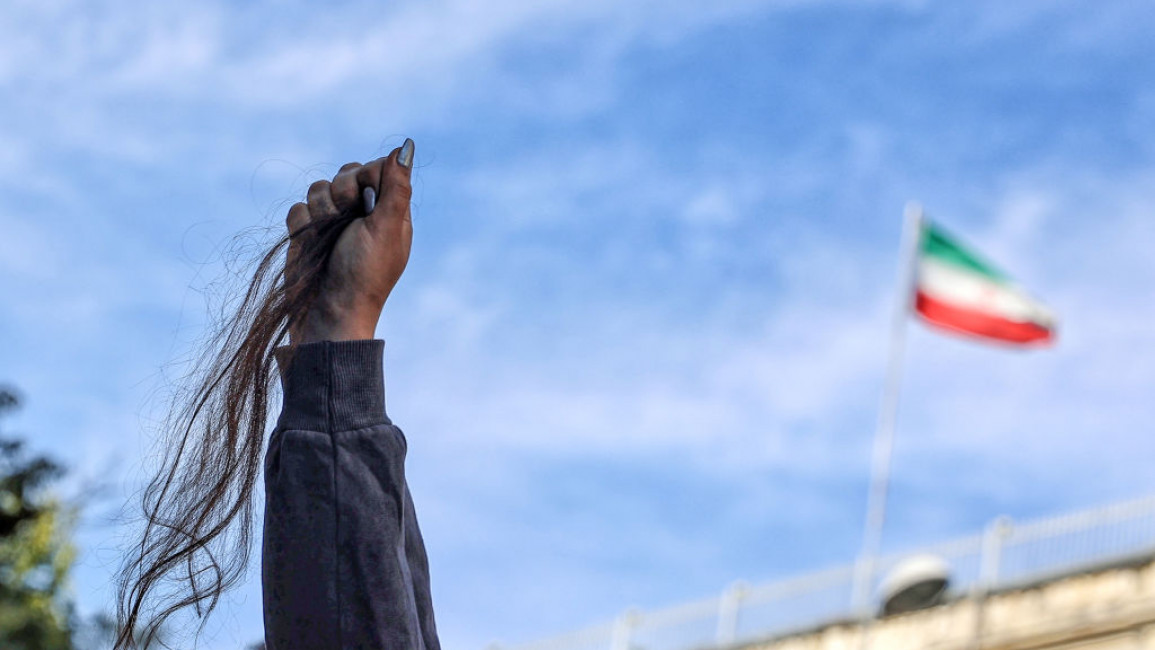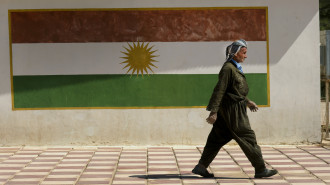
How Mahsa Amini's death permanently changed Iran

The 16th of September marked one year since the death in police custody of Mahsa Jina Amini, a 22-year-old Kurdish-Iranian woman from Saqqez.
When Amini was in Tehran just over a year ago, the Iranian “morality police” arrested her for allegedly not properly wearing the hijab in compliance with the laws of the Islamic Republic.
Although Iranian officials claim that she died from a heart attack unrelated to her situation in the “re-education” centre, Amini’s parents and Iranian protesters have rejected this official line, maintaining that she died from blows to her body while in custody.
What immediately followed Amini’s death in custody was a wave of protests that erupted all over Iran. In contrast to previous protests, the ones triggered by this young woman’s death took place in all provinces. Iranians came out in large urban areas, as well as in more rural and conservative parts of the country.
Although over time the protests lost steam, which was largely due to the government’s heavy-handed crackdown, the grievances that drove so many Iranians to the street remain unaddressed.
"The protests marked an inflection point, where the majority of the Iranian people gave up trying to find a modus vivendi with a regime that only cares about its own narrow core constituents"
A cultural revolution
The protests that broke out in September 2022 changed Iran in significant ways. Although the Islamic Republic has remained in power, which means that there was no successful political revolution, Iran has been, and still is, undergoing a cultural revolution.
“Today, the Iranian society, especially women, are moving the boundaries of [civil] disobedience and I believe that the balance of power between state and society will change, when more and more segments of society engage in [civil] disobedience, and that is when significant changes in governance structures will emerge in Iran,” said Dr Bijan Khajehpour, the managing partner at Vienna-based Eurasian Nexus, in an interview with The New Arab.
“How Iran changed since the death of Mahsa Amini is that Iranian women and girls essentially came to the street to fight mandatory hijab and said, ‘Enough is enough…You can’t kill a woman or girl because of how she’s dressed,’” Negar Mortazavi, a Washington-based Iranian journalist, host of The Iran Podcast, and senior fellow at the Center for International Policy, told TNA.
“The protests marked an inflection point, where the majority of the Iranian people gave up trying to find a modus vivendi with a regime that only cares about its own narrow core constituents,” explained Dr Ali Vaez, director of the International Crisis Group’s Iran Project, in a TNA interview.
“It was significant that women across the country showed up for [Amini]…it was also significant because this is a continuation of the daily fight of women that has been going on for four decades,” said Mortazavi.
“Since the beginning of the Islamic Republic, a specific group of women first protested the law of the mandatory hijab. Then it kept growing and growing with new generations joining. My own mother and aunt, then my own generation, and now the newer, younger generation [has] essentially [been] saying, ‘We want our bodily autonomy, we want to be able to dress how we want, and you can’t base it on one reading of the religion.’”
|
|
Challenges to the Islamic Republic's legitimacy
One year after Amini’s death in custody, Iran’s government is still facing its most serious legitimacy crisis since 1979. Segments of the country are fed up with the Islamic Republic’s economic, political, and social policies at a time when Iran’s middle class continues shrinking with more citizens living in poverty.
Of course, this is not entirely the fault of Iran’s government. The US is not an innocent or blameless actor. At least according to the architects of US sanctions on Iran, such policies have been designed to worsen these economic conditions in Iran, which exacerbate the regime’s legitimacy crisis. Regardless of Western motivations, the sanctions appear to have their desired effects when it comes to fuelling more opposition to the Islamic Republic on the part of wider segments of Iran’s population, particularly the youth.
A question worth asking is, could Iran’s worsening legitimacy crisis lead to the Islamic Republic facing an existential crisis? Considering the state’s monopoly on arms, power, and violence plus the fact that the protest movement lacks any leader, some experts are doubtful.
"It's not a matter of whether the system will be faced with another uprising, it's a matter of when, what sparks it, and whether the regime has anything to offer in response beyond internet blackouts, batons, and bullets"
“We don’t see the ingredients for an actual full-on revolution. Yes, it’s mass dissent, mass protests, but it’s also leaderless,” commented Mortazavi. “There are no serious political parties behind the street protests. It’s just very hard to imagine, at this stage, that the legitimacy crisis will translate into an immediate existential crisis, meaning that the state or regime is about to fall.”
Yet, the Iranian journalist explained that “if these cries for change, transformation, or revolution as the society wants are not heard by the state, and if policies stay rigid…I think the legitimacy crisis will just grow, run deeper, and get worse.”
Oppression, not reforms, is Iran's expected short-term future
Although Iran joining the Shanghai Cooperation Organisation, receiving an invitation to enter BRICS, and renormalising relations with Saudi Arabia in a Chinese-brokered diplomatic deal underscore how Iran is less isolated on the international stage compared to one year ago, it is unlikely that these developments in Tehran’s foreign policy will help the Islamic Republic overcome this legitimacy crisis at home.
Authorities in Tehran understand the magnitude of this crisis, and this is why the government has been relentless in terms of repressing dissent.
“There is grievance upon grievance that has been piling on and not addressed by the state. This poses a serious legitimacy crisis. The state understands that’s why they have to mobilise security forces to crackdown…on such protests and essentially react with such violence and brutality. Around 500 protests were killed, thousands were arrested, and a few were executed,” Mortazavi told TNA.
“The protests and government reaction have confirmed that the Iranian government has no intention of building back legitimacy or accommodating popular grievances,” Dr Sanam Vakil, director of the Middle East and North Africa programme at Chatham House, said in a TNA interview.
|
|
“What is popular legitimacy worth to the powers that be and how much of it do they actually possess? Not much,” said Dr Rouzbeh Parsi, the head of the Swedish Institute of International Affairs' Middle East and North Africa programme, told TNA.
“Effectively, meaningful reform from within is not on the horizon,” explained Dr Vakil. “To manage internal dissent, economic challenges, massive climate change pressure, and future Supreme Leader succession, Iran will be governed by a narrow exclusive group of loyalists and believers.”
During and after the Amini protests there were some voices optimistic enough to believe that the government in Tehran would agree to certain concessions along with specific political and social reforms in order to regain some lost legitimacy with reformist figures, such as former president Mohammad Khatami and former prime minister Mir-Hossein Mousavi.
"[The Islamic Republic] lost the battle of ideas because it's stopped offering any. It's all but given up on the battle for popular legitimacy"
“Instead, the government is doubling down on reinforcing veiling and social repression,” observed Dr Vakil. “Despite the hope that next year’s parliamentary elections would be more inclusive, the bureaucracy and academia are both being purged,” she added.
The Iranian government’s ability to weather the mass protest movement that began a year ago is merely “a pyrrhic victory in a much bigger contest that began before September last year, continues today, and will continue in the future,” Dr Vaez told TNA.
“[The Islamic Republic] lost the battle of ideas because it’s stopped offering any. It’s all but given up on the battle for popular legitimacy, which was already the case over the past few parliamentary and presidential elections.”
More sparks
Within this context of Iran’s authorities oppressing and cracking down on activists, lawyers, artists, journalists, academics, and entrepreneurs whom they see as contributing to the Islamic Republic’s legitimacy crisis, there is every reason to expect more uprisings to erupt in the future.
“It’s not a matter of whether the system will be faced with another uprising, it’s a matter of when, what sparks it, and whether the regime has anything to offer in response beyond internet blackouts, batons, and bullets,” according to Dr Vaez.
Mortazavi concurs. She believes that more mass protests will break out in Iran, “probably in shorter intervals, in shorter periods in between as the state continues to ignore the grievances and provide these sparks for the population.” Past sparks have included the Islamic Revolutionary Guard Corps’ shooting down of the Ukrainian passenger plane with 176 civilians on board in January 2020, soon after the 50 percent petrol price increase which triggered protests in response to the overnight hike of gas prices.
“This time [the spark] was the death in custody of a young woman for how she was dressed…This woman wasn’t a criminal. She wasn’t in a jail. She was just picked up on the street because of her attire. The state has essentially created these sparks. We’ve seen the society light up and now we’re seeing it light up in shorter intervals because of the situation with the economy and the social and political grievances that haven’t been addressed,” said Mortazavi.
With no signs of serious reforms being around the corner, Iran’s government will probably continue dealing with its legitimacy crisis through authoritarian methods. “The Islamic Republic is now a securitised Islamic state: the institution of elections and the system's republican institutions have become empty shells, and the men with guns have infiltrated all institutions of power,” Dr Vaez told TNA. “A minority rule regime can survive with brute force for a long time, but not forever.”
Dr Parsi believes that in the long run the Iranian system has to change. What remains to be seen is the tempo and scope of such change, how it is managed, and how orderly the change will be. “The more unwilling [Iran’s government] changes, the higher the cost for everyone,” he warned.
“There are of course those within the nezam (system) who believe themselves to be sufficiently impervious to societal pressure that they can continue without much change. There is a generational aspect here in that both the population and those who man the state apparatus will no longer belong to the founding generation nor the one who experienced the war with Iraq,” added Dr Parsi.
Giorgio Cafiero is the CEO of Gulf State Analytics.
Follow him on Twitter: @GiorgioCafiero





 Follow the Middle East's top stories in English at The New Arab on Google News
Follow the Middle East's top stories in English at The New Arab on Google News


